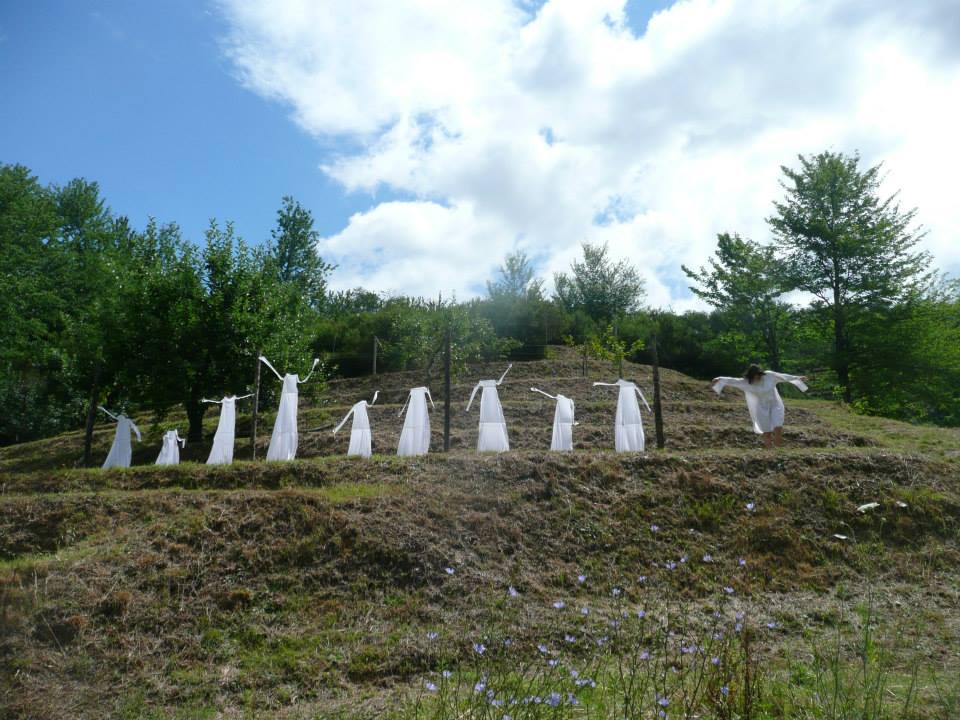 Go wild in the country! A reflection on artistic escape from the bright lights, big city – and a tale of two Feasts An ensemble of actors are gathered together to research the basic components of their craft in a workshop setting. The director gains inspiration from Japanese Noh Theatre and Commedia Dell’Arte. He expresses a desire to work with a bare stage, free from the trappings of cumbersome naturalistic stage sets. He views his work as a spiritual process that re-establishes theatre as a sacred space, and he is feeling increasingly frustrated with the demands of making work in a cosmopolitan setting. He longs to escape from the city…. The scene described above would not be too unusual today, but far from the usual expectations and practices of the theatre of its day, for this is Paris 1913. The director is Jacques Copeau, and the company is the Vieux-Colombier, which he has set up as a research project with the intention of restoring theatre to a purer art form of poetry and vision, based on the actor’s skill and inner strength. His influence on the physical and devised theatres of the twentieth century is phenomenal: from Copeau we can trace the line of influence through Antonin Artaud, who worked with Jean-Louis Barrault, one of Copeau’s dedicated pupils. Another of the dedicated troupe was a young working-class man called Etienne Decroux, who was to become known as the father of modern mime. Copeau’s daughter Marie-Helene befriended a young gymnast called Jacques Lecoq and through her, Lecoq had his introduction to theatre. The most radical phase of Copeau’s work took place when he decided in 1924 to leave the Parisian theatre world; to turn his back on the venues and producers and set-builders and first nights in the quest to find a different sort of theatre. Taking members of both the Vieux-Colombier company and its school he moved to Burgundy to create a theatre community that lived and worked together, celebrating birthdays with ritual, growing their own organic food and creating theatre pieces which were toured in the commedia dell’ arte tradition – playing outdoors in village squares, an integral part of the rural life that they had embraced.
Go wild in the country! A reflection on artistic escape from the bright lights, big city – and a tale of two Feasts An ensemble of actors are gathered together to research the basic components of their craft in a workshop setting. The director gains inspiration from Japanese Noh Theatre and Commedia Dell’Arte. He expresses a desire to work with a bare stage, free from the trappings of cumbersome naturalistic stage sets. He views his work as a spiritual process that re-establishes theatre as a sacred space, and he is feeling increasingly frustrated with the demands of making work in a cosmopolitan setting. He longs to escape from the city…. The scene described above would not be too unusual today, but far from the usual expectations and practices of the theatre of its day, for this is Paris 1913. The director is Jacques Copeau, and the company is the Vieux-Colombier, which he has set up as a research project with the intention of restoring theatre to a purer art form of poetry and vision, based on the actor’s skill and inner strength. His influence on the physical and devised theatres of the twentieth century is phenomenal: from Copeau we can trace the line of influence through Antonin Artaud, who worked with Jean-Louis Barrault, one of Copeau’s dedicated pupils. Another of the dedicated troupe was a young working-class man called Etienne Decroux, who was to become known as the father of modern mime. Copeau’s daughter Marie-Helene befriended a young gymnast called Jacques Lecoq and through her, Lecoq had his introduction to theatre. The most radical phase of Copeau’s work took place when he decided in 1924 to leave the Parisian theatre world; to turn his back on the venues and producers and set-builders and first nights in the quest to find a different sort of theatre. Taking members of both the Vieux-Colombier company and its school he moved to Burgundy to create a theatre community that lived and worked together, celebrating birthdays with ritual, growing their own organic food and creating theatre pieces which were toured in the commedia dell’ arte tradition – playing outdoors in village squares, an integral part of the rural life that they had embraced. 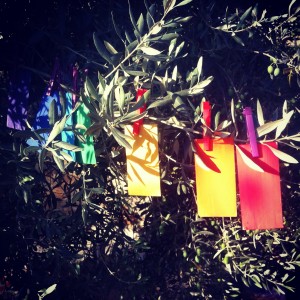 Moving on almost exactly a century, we find a young company, Clout (who formed whilst training at Ecole Jacques Lecoq in Paris and could thus be seen as descendants on a direct line down from Jacques Copeau) grappling with the same dilemma of the pressure of making theatre in the bustle of a big city environment. ‘Part and parcel of the theatre artist’s life is a kind of duality or split personality,’ says company co-founder and performer George Ramsay. ‘We are required to be sociable, extrovert and performative much of the time. We must sell ourselves on the streets of Edinburgh each August and remain connected to the ‘scene’ in our hometowns, in our case that being London. On the other hand creation often requires isolation, reflection and stillness.’ The company’s show How a Man Crumbled – made ‘in a dusty squat next to the rail tracks of La Chapelle in north Paris’ –had a very successful run at the Edinburgh Festival Fringe 2012, receiving a nomination for a Total Theatre Award for Emerging Artists. It subsequently toured round the UK, to Russia and Germany, and it got picked up by BAC, who gave it a week-long run and offered to support the making of the next show, The Various Lives of Infinite Nullity. Clout found themselves arriving at Edinburgh Fringe 2013 with a show that George feels ‘had many strong elements but wasn’t fully ready’. It nonetheless received excellent reviews and another Total Theatre Awards nomination. But the young company were feeling that everything was happening a little too quickly, and thus made the decision to spend a year in the wilderness, ‘both metaphorical and literal’. They gave the Ed Fringe 2014 a miss and spent time both re-developing The Various Lives of Infinite Nullity, and researching and creating a new show, FEAST. So in place of the hustle and bustle of Edinburgh, they spent their August in the wonderful theatre research centre Tiyatro Medresesi in rural Turkey, surrounded by olive groves, fig trees, stray cats and dogs, ancient architecture and plenty of cool yoghurt drinks. ‘We created and gave workshops, took walks, slept and collected bones,’ says George. ‘It was the antidote to filtering on the Royal Mile with the rain pouring down. We were again working in isolation. We had our privacy back.’ Reflecting on the effect that the surroundings have on the work, George says: ‘In a direct sense, we are often influenced by ambient sounds. In London, traffic sounds made tier way into the show, whilst in Turkey the sound of crickets chirruping became the soundtrack. However we can also react against our surroundings: in yuppie Battersea we created a dirty primal first chapter (Breakfast), all earth and milk and rough jute sacks, however in Turkey we made a highly cosmopolitan second chapter (Lunch), all high heels, giant colourful wigs and Norman Mailer quotes.’
Moving on almost exactly a century, we find a young company, Clout (who formed whilst training at Ecole Jacques Lecoq in Paris and could thus be seen as descendants on a direct line down from Jacques Copeau) grappling with the same dilemma of the pressure of making theatre in the bustle of a big city environment. ‘Part and parcel of the theatre artist’s life is a kind of duality or split personality,’ says company co-founder and performer George Ramsay. ‘We are required to be sociable, extrovert and performative much of the time. We must sell ourselves on the streets of Edinburgh each August and remain connected to the ‘scene’ in our hometowns, in our case that being London. On the other hand creation often requires isolation, reflection and stillness.’ The company’s show How a Man Crumbled – made ‘in a dusty squat next to the rail tracks of La Chapelle in north Paris’ –had a very successful run at the Edinburgh Festival Fringe 2012, receiving a nomination for a Total Theatre Award for Emerging Artists. It subsequently toured round the UK, to Russia and Germany, and it got picked up by BAC, who gave it a week-long run and offered to support the making of the next show, The Various Lives of Infinite Nullity. Clout found themselves arriving at Edinburgh Fringe 2013 with a show that George feels ‘had many strong elements but wasn’t fully ready’. It nonetheless received excellent reviews and another Total Theatre Awards nomination. But the young company were feeling that everything was happening a little too quickly, and thus made the decision to spend a year in the wilderness, ‘both metaphorical and literal’. They gave the Ed Fringe 2014 a miss and spent time both re-developing The Various Lives of Infinite Nullity, and researching and creating a new show, FEAST. So in place of the hustle and bustle of Edinburgh, they spent their August in the wonderful theatre research centre Tiyatro Medresesi in rural Turkey, surrounded by olive groves, fig trees, stray cats and dogs, ancient architecture and plenty of cool yoghurt drinks. ‘We created and gave workshops, took walks, slept and collected bones,’ says George. ‘It was the antidote to filtering on the Royal Mile with the rain pouring down. We were again working in isolation. We had our privacy back.’ Reflecting on the effect that the surroundings have on the work, George says: ‘In a direct sense, we are often influenced by ambient sounds. In London, traffic sounds made tier way into the show, whilst in Turkey the sound of crickets chirruping became the soundtrack. However we can also react against our surroundings: in yuppie Battersea we created a dirty primal first chapter (Breakfast), all earth and milk and rough jute sacks, however in Turkey we made a highly cosmopolitan second chapter (Lunch), all high heels, giant colourful wigs and Norman Mailer quotes.’ 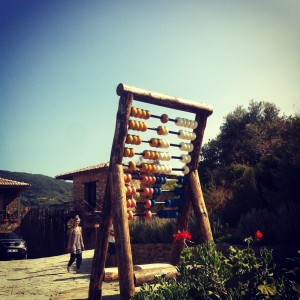 For Clout, the decision to leave the city lights is not to escape but to refresh and recharge: ‘In this debate between bucolic seclusion and cosmopolitan sociability it is not a case of one being better than the other, but rather a necessary dualism that we must embrace, and perpetually search for the right balance. And there is pleasure in this search.’ For others, though, it is not just a case of recharging batteries and escaping the metropolis in order to create work that will, ultimately, be brought back to theatre spaces – it is more a question of making work in the countryside that is specific to that environment, and remains there. The term’ site specific’ tends to conjure up visions of work made in abandoned warehouses and other urban spaces (see, for example, the work of Punchdrunk, Dreamthinkspeak, Geraldine Pilgrim et al). But there is a noble history of work that is made in, and for, the rural environment – work that is a response to that environment, and exists there and there alone. Artists and companies working in this way include the venerable Wrights and Sites (and their related Mythogeography project), environmental artists such as Red Earth, and John Fox and Sue Gill of Dead Good Guides (formerly co-directors of Welfare State International).
For Clout, the decision to leave the city lights is not to escape but to refresh and recharge: ‘In this debate between bucolic seclusion and cosmopolitan sociability it is not a case of one being better than the other, but rather a necessary dualism that we must embrace, and perpetually search for the right balance. And there is pleasure in this search.’ For others, though, it is not just a case of recharging batteries and escaping the metropolis in order to create work that will, ultimately, be brought back to theatre spaces – it is more a question of making work in the countryside that is specific to that environment, and remains there. The term’ site specific’ tends to conjure up visions of work made in abandoned warehouses and other urban spaces (see, for example, the work of Punchdrunk, Dreamthinkspeak, Geraldine Pilgrim et al). But there is a noble history of work that is made in, and for, the rural environment – work that is a response to that environment, and exists there and there alone. Artists and companies working in this way include the venerable Wrights and Sites (and their related Mythogeography project), environmental artists such as Red Earth, and John Fox and Sue Gill of Dead Good Guides (formerly co-directors of Welfare State International). 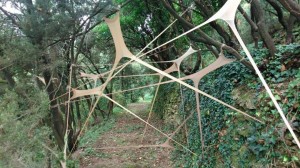 Isobel Smith is an artist whose work sits between the visual and performing arts. With her company Grist to the Mill, she makes visual theatre work using puppetry, animation, live and composed music, and physical performance. She is also a sculptor and installation maker. I’ve had the pleasure of collaborating with her on a number of projects, including a commission to make a site-responsive work for a mock-Victorian Bathing Machine on Brighton beach (Kissing the Gunner’s Daughter, one of Nightingale Theatre’s Dip Your Toe commissions for Brighton Fringe 2012). More recently, we have worked together on a project called Sisters of Hera, in which we were commissioned by Tenuta dello Scompiglio in Italy to be artists-in-residence at their beautiful site – an arts centre set on an organic farm and vineyard, surrounded by woods. The brief was for the project’s three key artists (Isobel, composer James Foz Foster, and myself) to visit three times, to make a succession of works that responded to the environment, with the project culminating in September 2014 with a showing of this work, curating further works made by other invited artists, together with an indoor show that aimed to bring some of the outdoor elements into an indoor immersive theatre environment.
Isobel Smith is an artist whose work sits between the visual and performing arts. With her company Grist to the Mill, she makes visual theatre work using puppetry, animation, live and composed music, and physical performance. She is also a sculptor and installation maker. I’ve had the pleasure of collaborating with her on a number of projects, including a commission to make a site-responsive work for a mock-Victorian Bathing Machine on Brighton beach (Kissing the Gunner’s Daughter, one of Nightingale Theatre’s Dip Your Toe commissions for Brighton Fringe 2012). More recently, we have worked together on a project called Sisters of Hera, in which we were commissioned by Tenuta dello Scompiglio in Italy to be artists-in-residence at their beautiful site – an arts centre set on an organic farm and vineyard, surrounded by woods. The brief was for the project’s three key artists (Isobel, composer James Foz Foster, and myself) to visit three times, to make a succession of works that responded to the environment, with the project culminating in September 2014 with a showing of this work, curating further works made by other invited artists, together with an indoor show that aimed to bring some of the outdoor elements into an indoor immersive theatre environment. 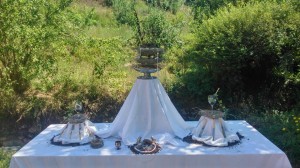 Speaking of the opportunity, Isobel says: ‘As is the tradition with artist’s residencies, being removed from the obligations of mundane tasks and routines like cleaning, laundry, shopping, cooking, school run, and being given time and space to explore artistic practice is opportunity enough. But being plucked from all that and transported in a Tuscan paradise for not one, but three visits spread over a year was akin to artist’s heaven – I had a rare moment in my life as an artist of feeling properly supported, enabled and valued to make work.’ So, with senses heightened, the rest of world ceased to exist whilst we were there in Tuscany – there was only the project. The Sisters of Hera – Hestia, goddess of hearth and home; and Demeter, goddess of fertility, earth and the harvest – were our initial inspiration. The task: to create a series of artworks, performances, compositions, and aural/visual installations celebrating Scompiglio’s dualities: indoors and outdoors; art and nature; architecture and agriculture. The works each, in their different ways, exploring classical and contemporary interpretations of the Olympian myths, and reflecting the desire to bring the outdoors in and the indoors out. Very early in the process, certain images presented themselves: wooden tables outdoors grazing wildly, then later as beasts of burden laden with the trappings of civilisation (pristine white linen, silverware, fine bone china); the notion of hybrid creatures, part-human, part-tree; creating shrines to goddesses in bird-boxes; bringing the trappings of vanity – mirrors and hairbrushes and evening gowns – out into the woods; bringing the trees and fruits of the forest indoors and using them in interesting sculptural and performative ways.
Speaking of the opportunity, Isobel says: ‘As is the tradition with artist’s residencies, being removed from the obligations of mundane tasks and routines like cleaning, laundry, shopping, cooking, school run, and being given time and space to explore artistic practice is opportunity enough. But being plucked from all that and transported in a Tuscan paradise for not one, but three visits spread over a year was akin to artist’s heaven – I had a rare moment in my life as an artist of feeling properly supported, enabled and valued to make work.’ So, with senses heightened, the rest of world ceased to exist whilst we were there in Tuscany – there was only the project. The Sisters of Hera – Hestia, goddess of hearth and home; and Demeter, goddess of fertility, earth and the harvest – were our initial inspiration. The task: to create a series of artworks, performances, compositions, and aural/visual installations celebrating Scompiglio’s dualities: indoors and outdoors; art and nature; architecture and agriculture. The works each, in their different ways, exploring classical and contemporary interpretations of the Olympian myths, and reflecting the desire to bring the outdoors in and the indoors out. Very early in the process, certain images presented themselves: wooden tables outdoors grazing wildly, then later as beasts of burden laden with the trappings of civilisation (pristine white linen, silverware, fine bone china); the notion of hybrid creatures, part-human, part-tree; creating shrines to goddesses in bird-boxes; bringing the trappings of vanity – mirrors and hairbrushes and evening gowns – out into the woods; bringing the trees and fruits of the forest indoors and using them in interesting sculptural and performative ways. 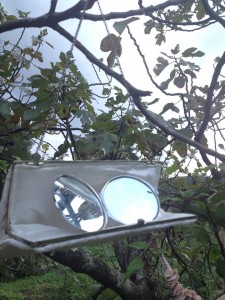 Reflecting on the first visit in April 2014, Isobel says: ‘We walked and walked, exploring the site and identifying possible locations for installations and outdoor performances.’ And what a choice there was! Woods and vineyards, creeks and meadows, terraced hills and mountain paths, abandoned outbuildings and old stone walls and fountains… Feeling the need to have some sort of unifying aesthetic for the diverse number of works being made, we decided on a kind of base design guideline: ‘Brown wood, rough un-bleached cloth, and earth was Demeter’s domain. Starchy white linen, candles and shiny silverware was Hestia’s,’ says Isobel. Dashes of harvest colours – rusty reds, damsons, apple greens – would creep in here and there.
Reflecting on the first visit in April 2014, Isobel says: ‘We walked and walked, exploring the site and identifying possible locations for installations and outdoor performances.’ And what a choice there was! Woods and vineyards, creeks and meadows, terraced hills and mountain paths, abandoned outbuildings and old stone walls and fountains… Feeling the need to have some sort of unifying aesthetic for the diverse number of works being made, we decided on a kind of base design guideline: ‘Brown wood, rough un-bleached cloth, and earth was Demeter’s domain. Starchy white linen, candles and shiny silverware was Hestia’s,’ says Isobel. Dashes of harvest colours – rusty reds, damsons, apple greens – would creep in here and there. 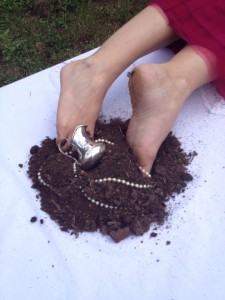 Composer/performer James Foz Foster found a tree he wanted to transform into a ‘Puppet Tree’, channelling the spirit of Pan by developing an idea to become a human musical puppet – tied into the tree with strings which activated bells when he moved to play the musical saw (with hands) and the Shruti box (using foot pedals); the costume a wonderful construction in Hessian and ivy, made by Isobel and inspired by Pan’s Northern European manifestation as the Green Man.
Composer/performer James Foz Foster found a tree he wanted to transform into a ‘Puppet Tree’, channelling the spirit of Pan by developing an idea to become a human musical puppet – tied into the tree with strings which activated bells when he moved to play the musical saw (with hands) and the Shruti box (using foot pedals); the costume a wonderful construction in Hessian and ivy, made by Isobel and inspired by Pan’s Northern European manifestation as the Green Man. 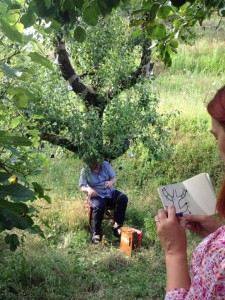 Other sites leapt out and sang to us: Isobel selected a disused hunter’s lodge at the height of the mountainous site for Running Cold, an installation to be glimpsed through a partially open door which would incorporate found objects, shadow work, and a soundscape composed by Foz. We became particularly interested in these ‘little houses in the woods’ and other built structures around the site– some, like the hunter’s lodge, damp and spider-infested; others like the ‘casa bambu’ pristine renovated spaces. This bamboo house felt the perfect place to site invited artist The Baron Gilvan, who was casting himself as inventor Daedalus, pondering the desire for flight. The little house thus became Daedalus’ Workshop, animated by live action painting by Gilvan. By co-incidence, another of the invited artists, Serena Gatti, proposed a piece about Icarus (Daedalus’ son, who in the Greek myths dies when he flies too close to the sun, melting his wax wings). Serena joined us on our second (July 2014) visit, and picked a site to work with in a creek at the very bottom of the valley, providing an interesting counter-balance to Daedalus’ Workshop at the top of the mountain… Another Daedalus-inspired piece saw Bruno Humberto re-creating the Minotaur’s labyrinth under a bridge (inspired by the Borges’ reworking of the classic myth).
Other sites leapt out and sang to us: Isobel selected a disused hunter’s lodge at the height of the mountainous site for Running Cold, an installation to be glimpsed through a partially open door which would incorporate found objects, shadow work, and a soundscape composed by Foz. We became particularly interested in these ‘little houses in the woods’ and other built structures around the site– some, like the hunter’s lodge, damp and spider-infested; others like the ‘casa bambu’ pristine renovated spaces. This bamboo house felt the perfect place to site invited artist The Baron Gilvan, who was casting himself as inventor Daedalus, pondering the desire for flight. The little house thus became Daedalus’ Workshop, animated by live action painting by Gilvan. By co-incidence, another of the invited artists, Serena Gatti, proposed a piece about Icarus (Daedalus’ son, who in the Greek myths dies when he flies too close to the sun, melting his wax wings). Serena joined us on our second (July 2014) visit, and picked a site to work with in a creek at the very bottom of the valley, providing an interesting counter-balance to Daedalus’ Workshop at the top of the mountain… Another Daedalus-inspired piece saw Bruno Humberto re-creating the Minotaur’s labyrinth under a bridge (inspired by the Borges’ reworking of the classic myth). 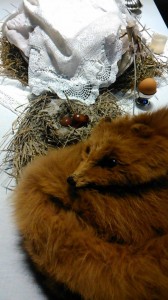 Elsewhere on the site, Isobel talks of the inspiration provided by the vineyards: ‘Wire frames looming over tiny freshly planted vine plants, waiting to force them into shape for maximum yield and easier picking. Man’s taming influence was in strong evidence throughout the well-managed site and Hestia’s concern with getting the table linen clean versus Demeter’s mud and earth ready to mess it up again became a near obsession for me.’ This obsession manifested in many ways, not least in Mandragola, a piece she installed during the July residency and left in the hands of the elements until September. When we returned, we were delighted to see that the pristine white ‘shrouds’, set on vine frames and dug into the earth in July, had ‘taken root’ in the ground. This second visit was focused heavily on making – having as much as possible of our own work completed (or at the very least planned) would enable us to concentrate on curating the visiting artists’ work, and rehearsing the indoor show, during the final visit. Isobel worked with Foz to put the structures in place for his Puppet Tree (later named The Bell Tree); Foz recorded chosen texts (in Italian and English) as the first-stage process of a number of compositions and sound installations that would be placed across the site (in chapels, old sinks, bushes, and brooks) and Isobel and I began a feverish bout of nest-making and bird-box creating, for both outdoor and indoor installations. In the third period, September 2014, we were joined by our guest artists (making 10 of us in total). ‘It was a very intense period and I enjoyed using all my skills and training to hop between roles of fine-artist, designer/maker, curator and performer, working alone at times and with everyone at others,’ says Isobel. ‘We ate, danced, rehearsed and performed together, drank wine, and made wonderful things happen’.
Elsewhere on the site, Isobel talks of the inspiration provided by the vineyards: ‘Wire frames looming over tiny freshly planted vine plants, waiting to force them into shape for maximum yield and easier picking. Man’s taming influence was in strong evidence throughout the well-managed site and Hestia’s concern with getting the table linen clean versus Demeter’s mud and earth ready to mess it up again became a near obsession for me.’ This obsession manifested in many ways, not least in Mandragola, a piece she installed during the July residency and left in the hands of the elements until September. When we returned, we were delighted to see that the pristine white ‘shrouds’, set on vine frames and dug into the earth in July, had ‘taken root’ in the ground. This second visit was focused heavily on making – having as much as possible of our own work completed (or at the very least planned) would enable us to concentrate on curating the visiting artists’ work, and rehearsing the indoor show, during the final visit. Isobel worked with Foz to put the structures in place for his Puppet Tree (later named The Bell Tree); Foz recorded chosen texts (in Italian and English) as the first-stage process of a number of compositions and sound installations that would be placed across the site (in chapels, old sinks, bushes, and brooks) and Isobel and I began a feverish bout of nest-making and bird-box creating, for both outdoor and indoor installations. In the third period, September 2014, we were joined by our guest artists (making 10 of us in total). ‘It was a very intense period and I enjoyed using all my skills and training to hop between roles of fine-artist, designer/maker, curator and performer, working alone at times and with everyone at others,’ says Isobel. ‘We ate, danced, rehearsed and performed together, drank wine, and made wonderful things happen’. 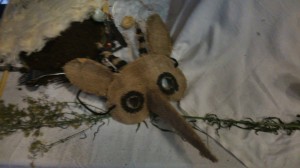 That final fortnight included midnight film-making in an abandoned fountain accompanied by a frog chorus (working under the direction of filmmaker Simon Wilkinson – the end result, Asleep on the Vine, an homage to Dionysus, was incorporated into the final show, and can be seen on Vimeo); morning rehearsals in the theatre space working on the indoor finale; and afternoons on-site creating the pieces for the great outdoors. Inevitably, this residency felt radically different to the earlier visits as there was an extended group of artists contributing ideas and making works, a deadline looming – and so, so much to do. The show must go on! The final showing to audience split the work into two parts: The Hunt was a daytime art-trail, audience members seeking out works of all sorts (painting, sculpture, sound installations, films, and short performance works), guided along the way by the multi-tasking Yael Karavan (who also performed in the evening show, created an installation, made a film called The Rape of Persephone referencing Demeter’s frantic search for her abducted daughter, and acted as camerawoman on Simon’s film). Following an Aperitif break at the site’s beautiful organic restaurant – where the audience enjoyed fine wines, local olives, and a very lovely sound installation in teapots made by Foz and animated by Marion Duggan and Matthew Blacklock, replendent in evening wear – the party were led off in silence at twilight for The Homecoming, which culminated in an interactive ‘Feast’ – set in the theatre space, although with the space turned topsy-turvy.
That final fortnight included midnight film-making in an abandoned fountain accompanied by a frog chorus (working under the direction of filmmaker Simon Wilkinson – the end result, Asleep on the Vine, an homage to Dionysus, was incorporated into the final show, and can be seen on Vimeo); morning rehearsals in the theatre space working on the indoor finale; and afternoons on-site creating the pieces for the great outdoors. Inevitably, this residency felt radically different to the earlier visits as there was an extended group of artists contributing ideas and making works, a deadline looming – and so, so much to do. The show must go on! The final showing to audience split the work into two parts: The Hunt was a daytime art-trail, audience members seeking out works of all sorts (painting, sculpture, sound installations, films, and short performance works), guided along the way by the multi-tasking Yael Karavan (who also performed in the evening show, created an installation, made a film called The Rape of Persephone referencing Demeter’s frantic search for her abducted daughter, and acted as camerawoman on Simon’s film). Following an Aperitif break at the site’s beautiful organic restaurant – where the audience enjoyed fine wines, local olives, and a very lovely sound installation in teapots made by Foz and animated by Marion Duggan and Matthew Blacklock, replendent in evening wear – the party were led off in silence at twilight for The Homecoming, which culminated in an interactive ‘Feast’ – set in the theatre space, although with the space turned topsy-turvy. 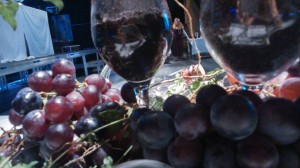 A specially built table cum altar was the central motif, set on the terraces where seating rakes would normally be (we liked the idea of the theatre terraces reflecting the vineyard and olive tree terraces sculpted into the Tuscan landscape). The audience and performers would inter-mingle at smaller tables, each a ‘shrine’ to a different god or goddess. Each performer had their own ‘station’ (Serena’s table, for example, was dedicated to Athena and featured clay bowls filled with olives, a roughly-hewn see-saw of scales, olive branches, feather quills, sheets of music manuscript). A section of the theatre floor was removed to create a red-lit pit circled with soil – Hades, from which Yael as Persephone emerged. The final scene of the show turned the underneath of the main table into a shadow world of tangled roots and branches. Although having the opportunity to show work to an audience is crucial, the residency, spanning most of a year, was about far more than the show – it was an opportunity to blossom as an artist in a holistic and nurturing environment. As Isobel notes: ‘The project would not have been possible in other circumstances. It needed the ease of living that this extraordinarily generous residency and commission allowed.’ For some (like Clout) escape to the countryside is all about the need to recharge your batteries, in order to have the breathing space to make new work that is then taken back into the city theatres. For others (like our Sisters of Hera project), the work resides in the place in which it is made. But in both cases, what is learnt through this withdrawal from the pressures of city life and escape to the countryside is that an engagement with the natural world feeds the soul and nurtures the artistic process. And the benefits and repercussions of this process will undoubtedly go far further than the immediate outcomes.
A specially built table cum altar was the central motif, set on the terraces where seating rakes would normally be (we liked the idea of the theatre terraces reflecting the vineyard and olive tree terraces sculpted into the Tuscan landscape). The audience and performers would inter-mingle at smaller tables, each a ‘shrine’ to a different god or goddess. Each performer had their own ‘station’ (Serena’s table, for example, was dedicated to Athena and featured clay bowls filled with olives, a roughly-hewn see-saw of scales, olive branches, feather quills, sheets of music manuscript). A section of the theatre floor was removed to create a red-lit pit circled with soil – Hades, from which Yael as Persephone emerged. The final scene of the show turned the underneath of the main table into a shadow world of tangled roots and branches. Although having the opportunity to show work to an audience is crucial, the residency, spanning most of a year, was about far more than the show – it was an opportunity to blossom as an artist in a holistic and nurturing environment. As Isobel notes: ‘The project would not have been possible in other circumstances. It needed the ease of living that this extraordinarily generous residency and commission allowed.’ For some (like Clout) escape to the countryside is all about the need to recharge your batteries, in order to have the breathing space to make new work that is then taken back into the city theatres. For others (like our Sisters of Hera project), the work resides in the place in which it is made. But in both cases, what is learnt through this withdrawal from the pressures of city life and escape to the countryside is that an engagement with the natural world feeds the soul and nurtures the artistic process. And the benefits and repercussions of this process will undoubtedly go far further than the immediate outcomes. 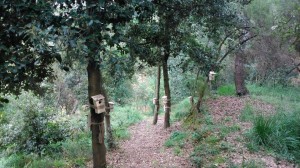 Photo credits: Clout photos (1 &2) courtesy of the company. Sisters of Hera photos (featured image & all others) by Isobel Smith. Further information: Clout are currently (November 2014) in residence at Battersea Arts Centre, performing the reworked version of The Various Lives of Infinite Nullity and the debut of new work FEAST. On 14 November, Clout are offering a food-themed, dada-infused cabaret in the bar after the show. They then perform their first show How a Man Crumbled at Mimetic Festival, The Vaults, 18–22 November 2014. Sisters of Hera, created by Aurelius Productions with Grist to the Mill, comprised three artistic residencies, in April, July & September 2014. Project Director/Curator Dorothy Max Prior, Co-Curator/Visual Artist Isobel Smith, Composer/Musical Director James Foz Foster. Guest artists joining for the September residency: Yael Karavan (Karavan Ensemble, Israel/UK), Simon Wilkinson (Circa 69, UK), Serena Gatti (Italy), Bruno Humberto (Portugal), The Baron Gilvan (UK), Matthew Blacklock & Marion Duggan (The Ragroof Players, UK). www.tenutadelloscompiglio.org
Photo credits: Clout photos (1 &2) courtesy of the company. Sisters of Hera photos (featured image & all others) by Isobel Smith. Further information: Clout are currently (November 2014) in residence at Battersea Arts Centre, performing the reworked version of The Various Lives of Infinite Nullity and the debut of new work FEAST. On 14 November, Clout are offering a food-themed, dada-infused cabaret in the bar after the show. They then perform their first show How a Man Crumbled at Mimetic Festival, The Vaults, 18–22 November 2014. Sisters of Hera, created by Aurelius Productions with Grist to the Mill, comprised three artistic residencies, in April, July & September 2014. Project Director/Curator Dorothy Max Prior, Co-Curator/Visual Artist Isobel Smith, Composer/Musical Director James Foz Foster. Guest artists joining for the September residency: Yael Karavan (Karavan Ensemble, Israel/UK), Simon Wilkinson (Circa 69, UK), Serena Gatti (Italy), Bruno Humberto (Portugal), The Baron Gilvan (UK), Matthew Blacklock & Marion Duggan (The Ragroof Players, UK). www.tenutadelloscompiglio.org

